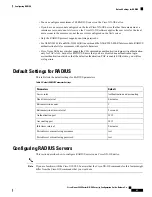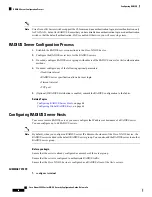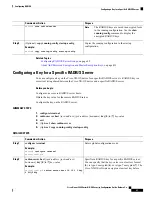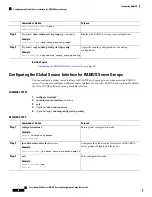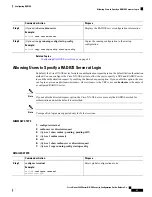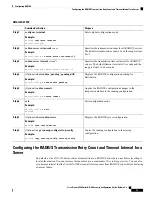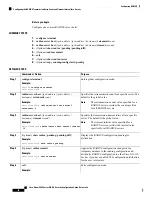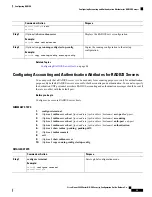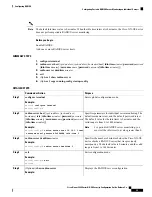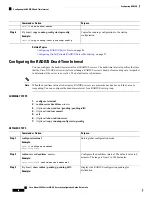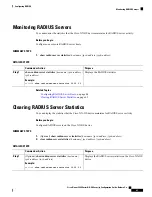
Before you begin
Configure one or more RADIUS server hosts.
SUMMARY STEPS
1.
configure terminal
2.
radius-server host
{
ipv4-address
|
ipv6-address
|
hostname
}
retransmit count
3.
radius-server host
{
ipv4-address
|
ipv6-address
|
hostname
}
timeout seconds
4.
(Optional)
show radius
{
pending
|
pending-diff
}
5.
(Optional)
radius commit
6.
exit
7.
(Optional)
show radius-server
8.
(Optional)
copy running-config startup-config
DETAILED STEPS
Purpose
Command or Action
Enters global configuration mode.
configure terminal
Example:
Step 1
switch#
configure terminal
switch(config)#
Specifies the retransmission count for a specific server. The
default is the global value.
radius-server host
{
ipv4-address
|
ipv6-address
|
hostname
}
retransmit count
Step 2
Example:
The retransmission count value specified for a
RADIUS server overrides the count specified
for all RADIUS servers.
Note
switch(config)#
radius-server host server1
retransmit 3
Specifies the transmission timeout interval for a specific
server. The default is the global value.
radius-server host
{
ipv4-address
|
ipv6-address
|
hostname
}
timeout seconds
Step 3
Example:
The timeout interval value specified for a
RADIUS server overrides the interval value
specified for all RADIUS servers.
Note
switch(config)#
radius-server host server1 timeout
10
Displays the RADIUS configuration pending for
distribution.
(Optional)
show radius
{
pending
|
pending-diff
}
Example:
Step 4
switch(config)#
show radius pending
Applies the RADIUS configuration changes in the
temporary database to the running configuration and
(Optional)
radius commit
Example:
Step 5
distributes RADIUS configuration to other Cisco NX-OS
switch(config)#
radius commit
devices if you have enabled CFS configuration distribution
for the user role feature.
Exits configuration mode.
exit
Example:
Step 6
Cisco Nexus 9000 Series NX-OS Security Configuration Guide, Release 9.x
54
Configuring RADIUS
Configuring the RADIUS Transmission Retry Count and Timeout Interval for a Server




